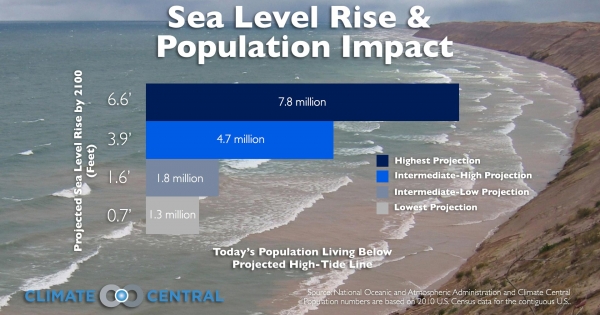Global Sea Level Rise: Impacts And Adaptation Strategies For Coastal Regions

Table of Contents
The Causes of Global Sea Level Rise
Global sea level rise is a complex phenomenon driven by multiple factors, primarily linked to climate change.
Thermal Expansion
Warming ocean temperatures are a major contributor to sea level rise. As ocean water absorbs heat from the atmosphere, it expands in volume, leading to a rise in sea level. This thermal expansion effect is significant and directly related to the increase in global average temperatures driven by greenhouse gas emissions.
- Global temperature increases of even a few degrees Celsius can result in substantial thermal expansion.
- Observed expansion rates show a clear correlation with rising global temperatures, confirming the impact of climate change.
- Greenhouse gases, such as carbon dioxide and methane, trap heat in the atmosphere, leading to warmer ocean temperatures and subsequent thermal expansion.
Melting Glaciers and Ice Sheets
The melting of glaciers and ice sheets in Greenland and Antarctica is another significant contributor to rising sea levels. The immense volume of ice stored in these regions represents a substantial potential for sea level rise.
- Studies show an accelerating rate of ice loss in Greenland and Antarctica, contributing significantly to global sea level rise.
- The melting of glaciers and ice sheets adds vast quantities of freshwater to the oceans, further increasing sea levels.
- Recent research indicates that the rate of ice melt is exceeding previous projections, highlighting the urgency of addressing climate change.
Groundwater Extraction
The depletion of groundwater resources for agriculture, industry, and domestic use contributes to land subsidence, effectively increasing relative sea level. As groundwater is withdrawn, the land above compacts, leading to a decrease in elevation.
- Land subsidence makes coastal regions more vulnerable to flooding and erosion.
- Regions with high rates of groundwater extraction, particularly in coastal areas, experience accelerated relative sea level rise.
- Sustainable groundwater management practices are crucial to mitigating land subsidence and reducing vulnerability to sea level rise.
Impacts of Global Sea Level Rise on Coastal Regions
The impacts of global sea level rise on coastal regions are far-reaching and devastating, affecting both natural ecosystems and human populations.
Coastal Erosion and Flooding
Rising sea levels exacerbate coastal erosion and increase the frequency and severity of flooding events. Coastal communities face increasingly frequent inundation, threatening lives, property, and infrastructure.
- Increased flooding leads to significant economic losses and displacement of populations.
- Coastal infrastructure, including roads, buildings, and ports, is vulnerable to damage and destruction from erosion and flooding.
- Low-lying coastal areas and island nations are particularly vulnerable to the impacts of sea level rise.
Saltwater Intrusion
Rising sea levels lead to saltwater intrusion into freshwater sources, impacting agriculture, drinking water supplies, and ecosystems. This intrusion contaminates freshwater aquifers and surface waters, rendering them unsuitable for human consumption and irrigation.
- Saltwater intrusion degrades soil quality, reducing agricultural productivity.
- Contaminated water sources pose significant risks to human health and require costly remediation efforts.
- Coastal communities relying on groundwater for drinking water are particularly vulnerable to saltwater intrusion.
Loss of Biodiversity and Habitat
Sea level rise threatens coastal ecosystems and biodiversity, leading to the loss of crucial habitats for numerous species. Mangroves, coral reefs, and other coastal ecosystems are particularly vulnerable.
- Rising sea levels can inundate and destroy coastal wetlands, reducing habitat for various plant and animal species.
- Coral reefs are sensitive to changes in salinity and temperature, making them vulnerable to sea level rise.
- Loss of biodiversity affects ecosystem services, such as fisheries and coastal protection, impacting human livelihoods.
Adaptation Strategies for Coastal Regions
Addressing the challenges of global sea level rise requires a multifaceted approach encompassing engineering solutions, managed retreat, ecosystem-based adaptation, and robust policy frameworks.
Engineering Solutions
Engineering solutions, such as seawalls, levees, and other coastal defenses, offer short-term protection against flooding and erosion. However, they are often expensive, may have negative environmental impacts, and may not be sustainable in the long term.
- Seawalls provide a physical barrier against rising sea levels but can disrupt natural coastal processes.
- Levees can protect inland areas but may be breached during extreme events.
- The high costs and potential environmental consequences of engineering solutions need careful consideration.
Managed Retreat
Managed retreat involves the planned relocation of people and infrastructure away from vulnerable coastal areas. This approach acknowledges the limitations of defending against rising sea levels in certain locations.
- Managed retreat can be a complex and socially challenging process, requiring careful planning and community engagement.
- Successful managed retreat initiatives require equitable compensation and support for relocated communities.
- Relocation strategies must consider environmental, social, and economic factors.
Ecosystem-Based Adaptation
Ecosystem-based adaptation uses natural systems to buffer against the impacts of sea level rise. Restoring and protecting coastal ecosystems, such as mangroves and dunes, provides natural defenses against erosion and flooding.
- Mangroves act as natural buffers against storm surges and erosion.
- Dune stabilization helps protect coastlines from erosion and flooding.
- Ecosystem-based adaptation offers cost-effective and environmentally friendly solutions.
Policy and Planning
Effective coastal zone management and planning are crucial for mitigating the impacts of sea level rise. This includes developing and enforcing building codes, land-use regulations, and integrated coastal zone management plans.
- Building codes should reflect the increased risks associated with sea level rise.
- Land-use planning should prioritize protection of vulnerable areas and promote sustainable development.
- International cooperation and data sharing are essential for effective adaptation strategies.
Conclusion
Global sea level rise presents a significant and escalating threat to coastal regions worldwide, impacting ecosystems, economies, and human lives. The causes are multifaceted, primarily linked to climate change and human activities. The consequences, including increased coastal erosion, flooding, saltwater intrusion, and biodiversity loss, demand urgent action. Implementing a combination of engineering solutions, managed retreat strategies, ecosystem-based adaptation, and robust policy frameworks is crucial for building resilient coastal communities and protecting vulnerable populations from the escalating threats of rising sea levels. Understanding the multifaceted challenges of global sea level rise is crucial. By implementing a combination of engineering solutions, managed retreat strategies, ecosystem-based adaptation, and robust policy frameworks, we can build resilient coastal communities and protect vulnerable populations from the escalating threats of rising sea levels.

Featured Posts
-
 Analyzing Aaron Judges Hall Of Fame Chances At The 1 000 Game Mark
May 11, 2025
Analyzing Aaron Judges Hall Of Fame Chances At The 1 000 Game Mark
May 11, 2025 -
 Yankees Vs Diamondbacks Injury Report April 1 3 Series
May 11, 2025
Yankees Vs Diamondbacks Injury Report April 1 3 Series
May 11, 2025 -
 Fin D Une Legende Thomas Mueller Quitte Le Bayern Munich
May 11, 2025
Fin D Une Legende Thomas Mueller Quitte Le Bayern Munich
May 11, 2025 -
 Celtics Secure Division Crown With Impressive Win
May 11, 2025
Celtics Secure Division Crown With Impressive Win
May 11, 2025 -
 Chainalysis Acquisition Of Alterya Boosting Blockchain Security With Ai
May 11, 2025
Chainalysis Acquisition Of Alterya Boosting Blockchain Security With Ai
May 11, 2025
Latest Posts
-
 Possible Successors To Pope Francis Leading Candidates For The Papacy
May 12, 2025
Possible Successors To Pope Francis Leading Candidates For The Papacy
May 12, 2025 -
 Who Will Be The Next Pope Analyzing The Top Contenders
May 12, 2025
Who Will Be The Next Pope Analyzing The Top Contenders
May 12, 2025 -
 The Next Pope Examining The Leading Candidates To Succeed Francis
May 12, 2025
The Next Pope Examining The Leading Candidates To Succeed Francis
May 12, 2025 -
 High Stakes Wbc Eliminator Cissokho Takes On Kavaliauskas
May 12, 2025
High Stakes Wbc Eliminator Cissokho Takes On Kavaliauskas
May 12, 2025 -
 After Pope Francis 9 Potential Successors And The Future Of The Catholic Church
May 12, 2025
After Pope Francis 9 Potential Successors And The Future Of The Catholic Church
May 12, 2025
